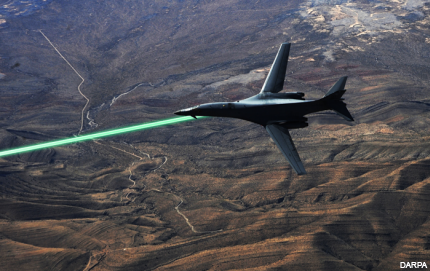High-power laser weapon advances to field testing
The HELLADS project, funded by DARPA and the Air Force Research Lab, is shooting for a small, lightweight laser capable of 150 kilowatts of output.

A DARPA illustration depicts HELLADS in action.
The Pentagon’s pursuit of high-energy laser weapons is taking another step forward, with the decision to move the High-Energy Liquid Laser Area Defense System from lab development into active field tests.
HELLADS, a project jointly funded by the Defense Advanced Research Projects Agency and the Air Force Research Laboratory, will begin field tests this summer at White Sands Missile Range, N.M., being used against rockets, mortars, vehicles and surrogate surface-to-air missiles, DARPA said.
“The technical hurdles were daunting, but it is extremely gratifying to have produced a new type of solid-state laser with unprecedented power and beam quality for its size,” said Rich Bagnell, DARPA program manager. “The HELLADS laser is now ready to be put to the test on the range against some of the toughest tactical threats our warfighters face.”
The goal of the HELLADS program, which was kicked off in 2001, is to develop a laser capable of 150-kilowatt bursts while being 10 times smaller and lighter than current lasers of comparable power. Those size and weight reductions—the objective is 3 cubic meters in size and less than 5 kilograms per kilowatt of power—would allow the system to be mounted on tactical aircraft for use against ground threats, DARPA said.
Power requirements and energy output have been the big challenges for solid state lasers, which military researchers moved to after determining that their chemical-based predecessors, which date to the 1980s, were too unwieldy and risky, despite their megawatt power. Military research labs have for years been testing fairly low-power lasers, with the aim of exceeding 100 kilowatts of directed-energy output, seen at the threshold for a weapons-grade system that can take out small ground vehicles, boats and drones.
The Navy last year deployed its first shipboard laser weapon, known as LaWS, in the Persian Gulf. The Army, Air Force and Marines also are in various stages of laser-weapon development.
Effective lasers could save the military a lot of money, since a laser might cost a dollar or two per shot, as opposed to thousands or more for conventional weapons. Lasers also wouldn’t run out of ammunition, as along as a power supply is available.
Taking HELLADS, which is being developed by General Atomics, into field testing could bring lasers closer to wide deployment. DARPA said that, following the tests, it hopes to make HELLADS available to the services for further testing a refinement.



